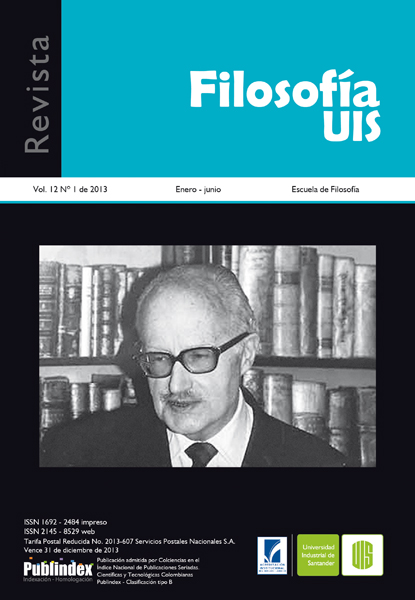Dialectical images and anachronism in art history (according to Georges Didi-Huberman)
Published 2013-09-13
Keywords
- history,
- memory,
- images,
- anachronism,
- dialectics
How to Cite
Copyright (c) 2013 Carlos Mario Fisgativa Sabogal

This work is licensed under a Creative Commons Attribution 4.0 International License.
Abstract
One of the main theoretical proposals by Georges Didi-Huberman is his intent of thinking art’s history as an anachronistic discipline. That is possible starting from Walter Benjamin concept of dialectical image as a method for historical research. Because the historian’s procedure opposes heterogeneous fragments, ruins and heterogeneous objects to obtain a non-synthetic image of the past. This procedure retrieves all that remains invincible for historical progress; but in spite of that, refuses to disappear and remains between the ruins and ashes of history. This method makes possible for Didi-Huberman to introduce images’ anachronism on art history supported on the dialectical montage of images. It implies to question the dominant progressive temporality of art’s history, and also, to find epistemological alternatives for the image as knowledge about art and culture.
Downloads
References
- Benjamin, W. (1971). Angelus Novus. Barcelona: Edhasa.
- Benjamin, W. (1980). “París, capital del siglo XIX”. Iluminaciones II: poesía y capitalismo. Madrid: Taurus, pp. 171-190.
- Benjamin, W. (2001). “Sobre el lenguaje en general y sobre el lenguaje de los hombres”. Ensayos escogidos. México: Ediciones Coyoacán.
- Benjamin, W. (2001). Iluminaciones IV. España: Taurus.
- Benjamin, W. (2005). Libro de los pasajes. Madrid: Akal Ediciones.
- Benjamin, W. (2006). “El origen del Trauerspiel alemán”. Obras. Libro I. Volumen. I. Madrid: Abade.
- Didi-Huberman, G. (1997). Lo que vemos, lo que nos mira. Buenos Aires. Manantial.
- Didi-Huberman, G. (2004). Imágenes pese a todo. Barcelona: Paidós.
- Didi-Huberman, G. (2005). Confronting Images. Questioning the Ends of a Certain History of Art. Pennsylvania: Pennsylvania State University Press.
- Didi-Huberman, G. (2008a). Ante el tiempo. Historia del tiempo y anacronismo de las imágenes. Buenos Aires: Adriana Hidalgo Editora.
- Didi-Huberman, G. (2008b). Cuando las imágenes toman posición. El ojo de la historia.1. España: A. Machado Libros.
- Didi-Huberman, G. (2008c). “La emoción no dice ‘yo’. Diez fragmentos sobre la libertad estética”. V.V.A.A. Alfredo Jaar. La política de las imágenes. Santiago de Chile: Metales pesados.
- Didi-Huberman, G. (2008d). Ser cráneo. Lugar, contacto, pensamiento, escultura. Bogotá: Universidad Nacional de Colombia – Facultad de Artes.
- Didi-Huberman, G. (2009). La imagen superviviente. Historia del arte y tiempo de los fantasmas según Aby Warburg. Madrid: Abada Editores.
- Rancière, J. (2007). The Future of the Image. London: Verso Books.
- Rancière, J. (2010). El espectador emancipado. Buenos Aires: Manantial.
- Warburg, A. (2010). Atlas Mnemosyne. Madrid: Akal.
- CIBERGRAFÍA
- Didi-Huberman, G. (1995). Le lieu malgré tout. Recuperado de: http://www.jstor. org/stable/3771544. Consultado el 21 de octubre de 2008.
